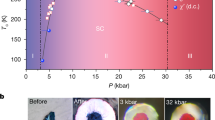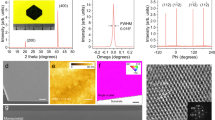Abstract
In microgravity, crystals of semiconductors and proteins can be grown with improved crystallinity, offering the prospect of improved structural analyses (for proteins) and better electronic properties (for semiconductors)1,2,3. Here we study the effect of a microgravity environment on the crystallization of a class of materials—layered microporous tin(IV) sulphides4,5,6,7,8,9,10,11—whose crystal structure is determined by weak interlayer interactions (electrostatic, hydrogen-bonding and van der Waals) as well as strong intralayer covalent bonds. We find that the crystals grown in microgravity (on board the Space Shuttle Endeavour) show improved crystal habits, smoother faces, greater crystallinity, better optical quality and larger void volumes than the materials grown on Earth. These differences are due at least in part to the profound influence of microgravity on the layer registry over length scales of around a nanometre, which is shown by X-ray and electron diffraction to be better in space than on Earth. Thus we can see a clear distinction between the covalent bonds in these materials, which are not significantly affected by microgravity, and the weaker forces (like those that determine the structure of proteins over length scales of around 0.3–0.4 nm) which are more susceptible to the dynamic disturbances that operate in crystallization on Earth.
This is a preview of subscription content, access via your institution
Access options
Subscribe to this journal
Receive 51 print issues and online access
$199.00 per year
only $3.90 per issue
Buy this article
- Purchase on Springer Link
- Instant access to full article PDF
Prices may be subject to local taxes which are calculated during checkout



Similar content being viewed by others
References
Feuerbacher, B., Hamacher, H. & Naumann, R. J. (eds) Materials Sciences in Space(Springer, Berlin, (1986)).
Space Science in the Twenty-First Century. Imperatives for the Decades 1995–2015—Overview and Fundamental Physics and Chemistry(Space Science Board, Natl Res. Council, Natl Academy Press, Washington DC, (1988)).
Towards a Microgravity Research Strategy(Committee on Microgravity Research, Space Studies Board, Natl Academy Press, Washington DC, (1992)).
Ahari, H.et al. Microporous tin(IV) chalcogenides: flexible framework materials for molecule discrimination. Adv. Mater. 7, 375–378 (1995).
Jiang, T.et al. Synthesis and structures of novel microporous tin(IV) sulfide materials. TPA-SnS-3 and TBA-SnS-3. Chem. Mater. 7, 245–248 (1995).
Ozin, G. A. & Bowes, C. L. Self-assembling frameworks. Adv. Mater. 8, 13–28 (1996).
Ozin, G. A. Microporous and mesoporous electronic materials: towards the electronic nose. Supramol. Chem. 6, 125–134 (1995).
Ozin, G. A.et al. Electronic sieves: Microporous layered tin (IV) sulfides. A new class of sensory materials. Proc. 9th Int. Symp. on Molecular Recognition and Inclusion(ed. Coleman, A.) (Kluwer Academic, Dordrecht, Netherlands, (1997)).
Jiang, T., Ozin, G. A. & Young, D. Microporous tin(IV) sulfides: mode of formation. Adv. Mater. 6, 860–865 (1994).
Francis, R. J.et al., Hydrothermal synthesis of microporous tin sulfides studied by real time in situ energy dispersive X-ray diffraction. Chem. Mater. 8, 2102–2108 (1996).
Jiang, T. Porous Tin(IV) sulfides, Thesis, Univ. Toronto, (1997).
Williams, D. B. & Carter, C. B. Transmission Electron Microscopy. A Textbook for Materials Science(Plenum, New York, (1996)).
Dag, Ö et al. Does microgravity influence self-assembly? A comparative investigation of the crystal growth of self-assembling microporous layered tin(IV) sulfides under microgravity conditions. Adv. Mater. (in the press).
Acknowledgements
This work was supported by the Natural Sciences and Engineering Research Council of Canada, Universal Oil Products, Communication Development, the Canadian Space Agency and NASA.
Author information
Authors and Affiliations
Rights and permissions
About this article
Cite this article
Ahari, H., Bedard, R., Bowes, C. et al. Effect of microgravity on the crystallization of a self-assembling layered material. Nature 388, 857–860 (1997). https://doi.org/10.1038/42213
Received:
Accepted:
Issue Date:
DOI: https://doi.org/10.1038/42213
This article is cited by
-
Dynamic Light Scattering on Nanoparticles in Microgravity in a Drop Tower
Microgravity Science and Technology (2022)
-
Protein structural changes on a CubeSat under rocket acceleration profile
npj Microgravity (2020)
Comments
By submitting a comment you agree to abide by our Terms and Community Guidelines. If you find something abusive or that does not comply with our terms or guidelines please flag it as inappropriate.



